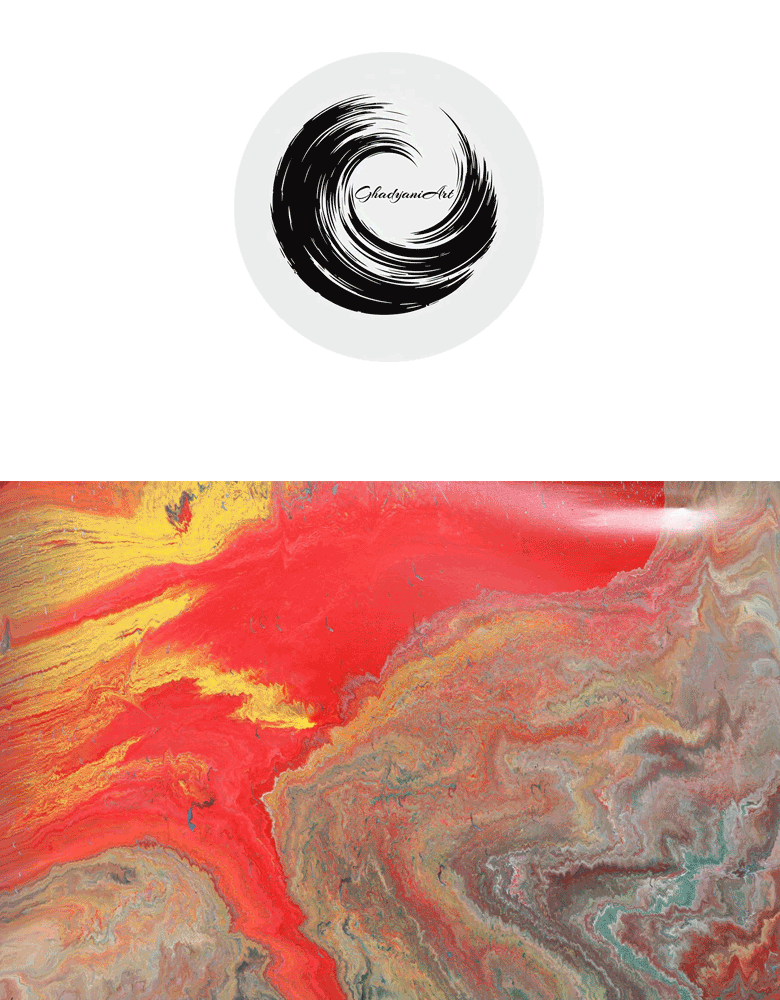
Volcanic Symphony

Title: Volcanic Symphony
Style: Abstract
Size: 100x70 cm
Medium: Canvas - Oil Paint
Description
Volcanic Symphony is a striking abstract painting by Iranian artist Abbas Ghadyani, created with oil on canvas in a 70×100 cm format. This artwork explodes with fiery reds, radiant yellows, and deep earthy tones, embodying both the destructive power and the creative force of nature.
At first glance, the viewer is confronted with torrents of molten colors flowing outward from the center of the canvas, resembling the eruption of lava from the heart of a volcano. The dynamic energy of the painting lies in its contrasts: blazing reds and yellows surge with intensity, while darker browns and grays stabilize the composition, echoing the dual nature of nature itself—violent yet grounding, chaotic yet ordered.
Technique and Methods
Ghadyani employs oil painting techniques that emphasize both freedom and structure:
1. Layering of vivid pigments– Reds and yellows are applied in bold, textured strokes, simulating molten lava spilling across the canvas.
2. Varied textures – Some areas flow smoothly, evoking liquid motion, while others are built up with thicker paint, giving the surface a tactile, almost geological presence.
3. Dynamic brushwork– Sweeping, free strokes create a sense of eruption and outward force, mirroring the natural energy of volcanic activity.
4.Contrasting color palette – Fiery warm tones are juxtaposed with stabilizing earthy hues, producing both visual tension and balance.
The result is a painting that not only dazzles the eye but also conveys rhythm and intensity—qualities that align with the concept of a symphony.
Artistic Details and Composition
The composition of Volcanic Symphony is built on movement and contrast. The central eruption of color commands immediate attention, while the darker peripheries frame and balance the composition.
Focal Point: The core of the canvas, where reds and yellows collide most intensely, serves as the visual climax of the piece.
Movement: Colors radiate outward from the center in sweeping gestures, mimicking the explosive momentum of volcanic eruption.
Texture: In certain regions, the paint twists and ripples like molten rock, while in others, smoother transitions suggest the cooling calm after eruption.
This structural interplay creates a sense of rhythm and harmony, echoing the rise and fall of a musical symphony rendered in pigment and form.
Message and Meaning
At its core, Volcanic Symphony is about energy, transformation, and duality. Just as volcanoes form silently beneath the earth before erupting with overwhelming force, human emotions and creative impulses often build quietly before bursting forth in moments of passion and expression.
The painting symbolizes both creation and destruction. Fiery colors can be interpreted as life, vitality, and renewal, while at the same time evoking danger, upheaval, and transformation. This duality reflects the paradox of existence itself: beauty within chaos, birth within death, calm within storm.
Philosophically, the painting points to the perpetual cycle of transformation that defines both nature and human life. Every eruption, no matter how violent, paves the way for new landscapes and possibilities. Volcanic Symphony becomes a hymn to change, a visual composition where destruction and creation merge into one.
Conclusion
Volcanic Symphony is a testament to Abbas Ghadyani’s ability to harness color, motion, and meaning in the language of abstraction. Through fiery reds, brilliant yellows, and the grounding force of earth tones, he creates a painting that resonates on both visual and philosophical levels.
Like a true symphony, this artwork is composed of crescendos and silences, clashes and harmonies. It invites viewers not only to see but to feel—the heat of lava, the roar of eruption, and the calm that follows.
Ultimately, Volcanic Symphony is more than a painting: it is a reflection of nature’s immense power and the human spirit’s capacity for transformation. It stands as an emblem of how abstract art can turn elemental forces into a poetic experience, leaving the viewer both humbled and inspired.
